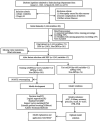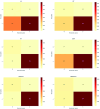Development and internal validation of an interpretable risk prediction model for diabetic peripheral neuropathy in type 2 diabetes: a single-centre retrospective cohort study in China
- PMID: 40180384
- PMCID: PMC11969608
- DOI: 10.1136/bmjopen-2024-092463
Development and internal validation of an interpretable risk prediction model for diabetic peripheral neuropathy in type 2 diabetes: a single-centre retrospective cohort study in China
Abstract
Objective: Diabetic peripheral neuropathy (DPN) is a common and serious complication of diabetes, which can lead to foot deformity, ulceration, and even amputation. Early identification is crucial, as more than half of DPN patients are asymptomatic in the early stage. This study aimed to develop and validate multiple risk prediction models for DPN in patients with type 2 diabetes mellitus (T2DM) and to apply the Shapley Additive Explanation (SHAP) method to interpret the best-performing model and identify key risk factors for DPN.
Design: A single-centre retrospective cohort study.
Setting: The study was conducted at a tertiary teaching hospital in Hainan.
Participants and methods: Data were retrospectively collected from the electronic medical records of patients with diabetes admitted between 1 January 2021 and 28 March 2023. After data preprocessing, 73 variables were retained for baseline analysis. Feature selection was performed using univariate analysis combined with recursive feature elimination (RFE). The dataset was split into training and test sets in an 8:2 ratio, with the training set balanced via the Synthetic Minority Over-sampling Technique. Six machine learning algorithms were applied to develop prediction models for DPN. Hyperparameters were optimised using grid search with 10-fold cross-validation. Model performance was assessed using various metrics on the test set, and the SHAP method was used to interpret the best-performing model.
Results: The study included 3343 T2DM inpatients, with a median age of 60 years (IQR 53-69), and 88.6% (2962/3343) had DPN. The RFE method identified 12 key factors for model construction. Among the six models, XGBoost showed the best predictive performance, achieving an area under the curve of 0.960, accuracy of 0.927, precision of 0.969, recall of 0.948, F1-score of 0.958 and a G-mean of 0.850 on the test set. The SHAP analysis highlighted C reactive protein, total bile acids, gamma-glutamyl transpeptidase, age and lipoprotein(a) as the top five predictors of DPN.
Conclusions: The machine learning approach successfully established a DPN risk prediction model with excellent performance. The use of the interpretable SHAP method could enhance the model's clinical applicability.
Keywords: Diabetes Mellitus, Type 2; Diabetic neuropathy; Machine Learning; Retrospective Studies; Risk Factors.
© Author(s) (or their employer(s)) 2025. Re-use permitted under CC BY-NC. No commercial re-use. See rights and permissions. Published by BMJ Group.
Conflict of interest statement
Competing interests: None declared.
Figures






Similar articles
-
Predictive model and risk analysis for peripheral vascular disease in type 2 diabetes mellitus patients using machine learning and shapley additive explanation.Front Endocrinol (Lausanne). 2024 Feb 28;15:1320335. doi: 10.3389/fendo.2024.1320335. eCollection 2024. Front Endocrinol (Lausanne). 2024. PMID: 38481447 Free PMC article.
-
Interpretable machine learning models for detecting peripheral neuropathy and lower extremity arterial disease in diabetics: an analysis of critical shared and unique risk factors.BMC Med Inform Decis Mak. 2024 Jul 22;24(1):200. doi: 10.1186/s12911-024-02595-z. BMC Med Inform Decis Mak. 2024. PMID: 39039521 Free PMC article.
-
Study on risk factors of diabetic peripheral neuropathy and establishment of a prediction model by machine learning.BMC Med Inform Decis Mak. 2023 Aug 2;23(1):146. doi: 10.1186/s12911-023-02232-1. BMC Med Inform Decis Mak. 2023. PMID: 37533059 Free PMC article.
-
Development and validation of a risk prediction model for early diabetic peripheral neuropathy based on a systematic review and meta-analysis.Front Public Health. 2023 Feb 22;11:1128069. doi: 10.3389/fpubh.2023.1128069. eCollection 2023. Front Public Health. 2023. PMID: 36908480 Free PMC article.
-
Towards prevention of diabetic peripheral neuropathy: clinical presentation, pathogenesis, and new treatments.Lancet Neurol. 2022 Oct;21(10):922-936. doi: 10.1016/S1474-4422(22)00188-0. Lancet Neurol. 2022. PMID: 36115364 Free PMC article. Review.
Cited by
-
Machine learning-based prediction of diabetic peripheral neuropathy: model development and clinical validation.Front Endocrinol (Lausanne). 2025 Jun 5;16:1614657. doi: 10.3389/fendo.2025.1614657. eCollection 2025. Front Endocrinol (Lausanne). 2025. PMID: 40538804 Free PMC article.
References
Publication types
MeSH terms
LinkOut - more resources
Full Text Sources
Medical
Research Materials
